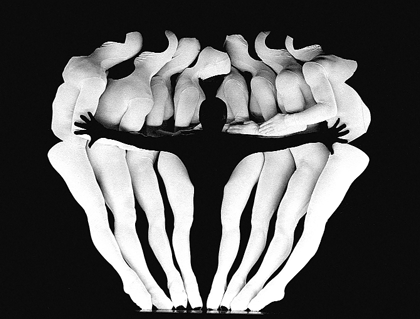An impersonal sequel, “Lunar Sea” gets caught in a faceless crater
By GUS SOLOMONS JR.
After the triumphant reprise of “Opus Cactus” during its opening week at the Joyce Theater, Moses Pendleton’s company Momix premiered “Lunar Sea” for the remaining two weeks of its run, through May 29.
Pendleton, one of the founding fathers of the perennial Pilobolus troupe—which makes its annual Joyce sojourn later this summer—founded Momix to make his own statement, and the company’s in such demand it now has three touring units.
What made “Opus” wonderful was seeing how Pendleton’s imagination turned humans into desert flora and fauna. In “Lunar Sea,” black light makes the white sides of the dancers glow. The black-and-white costumes, made by Phoebe Katzin in collaboration with Pendleton and associate director Cynthia Quinn, make the dancers look like humans who’ve been torn in half—a leg, an arm and a torso with an irregular side.
The eight dancers tilt at impossible angles, skidder back and forth like fanciful one-legged underwater creatures and pair up to become bipeds. The dancers’ supporting legs are invisible, so the composite beings appear to hover and glide in mid-air.
The jagged figures undulate, dart, roll and squiggle in the murky light like denizens of some alien abyss. Lively jellyfish wriggle—five women opening and closing umbrellas draped in silky fabric. Dancers cluster their white halves into a solid wall, and an all-black silhouette pierces it, crawls through and disappears. Part one ends with the dancers climbing into a tableau that resembles a snow-covered mountaintop.
In his habitual compositional mode, Pendleton strings together short episodes, each set to a different selection of rhythmic or exotic New Age music, creating a kind of kinetic revue. He first created part one of “Lunar Sea” as a commission for The Aspen/Santa Fe Ballet. As a stand-alone ballet for that kind of contemporary company, it’s a refreshing novelty.
However, Pendleton has added a second part to make it evening-length, and the expansion pushes the black-light gimmick over the edge. The glaring intensity of white forms in blackness takes its toll on the eyes—and the nerves—before the show’s 85 intermission-free minutes are over.
Part of the trouble with “Lunar Sea” is that it has no human face. There’s an amusing section for four bathing beauties bouncing rambunctiously on exercise balls, their one-piece bathing suits and ponytails glowing awhite. But they’re still faceless. The only time we do see faces is in an acrobatic adagio of Pilobolus-style leveraged lifts for a man and woman in gold bikinis, bathed in rosy light—a nice contrast to the monochrome—but their heads are mostly tucked in each other’s crotches.
And much of part two substitutes puppets for people altogether—a flying wraith by puppetmaker Michael Curry zooms through space; stretchy stockings dance a wacky chorus line, and then connect into spidery predators, one of which eats the other to over-the-top movie music. The episode is charming, but we miss people, as props take over.
Kaleidoscopic video images, also designed by Pendleton, project on a transparent scrim at the proscenium to enhance the mysterious undersea imagery. But the scrim separates us from the performers, and the blackness surrounding the harsh fluorescence eventually makes it hard to stay focused. “Lunar Sea” ends with a whimper, as the stretchy scarves form an octagonal blossom—or perhaps an octopus—that hovers in the air; it’s echoed by one projected on the alienating scrim that’s kept us at arm’s length throughout.
What made “Opus Cactus” so engaging was watching talented dancers magically transforming their moving bodies into creatures. Here, the imagery is weird and wild, but the talented performers remain largely invisible—and stuck behind a curtain to boot. “Lunar Sea” looks like an enticing video game, but we can’t get up close or play with the joystick, so it’s no fun.
gaycitynews.com


































